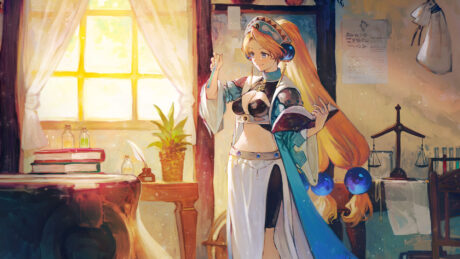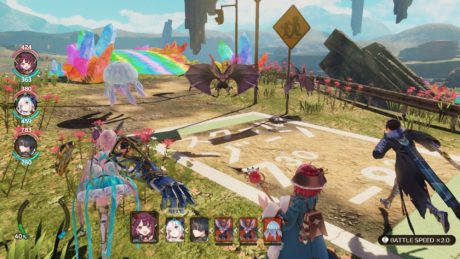Purrr....
- Duplicating
- Clean UI
- Alchemy fun
- Fast travel
- Tag-team attacks
Hisss!
- Silver Crystal hiccup
- Can’t swap characters freely in battle
- Exploration can be aggravating
Platform
Switch, PlayStation 4, PCPublisher
Koei TecmoDeveloper
GustSeries
AtelierGenre
RPGPlayers
1File Size (Minimum)
6.1 GBRelease Date (NA)
Feb 25, 2022Release Date (JP)
Feb 24, 2022Filed Under
Atelier Sophie 2: The Alchemist of the Mysterious Dream is the sequel to the 2015 game Atelier Sophie. It provides an updated and cleaner look while still making the game entertaining for those who enjoy crafting.
Small World but Dreamy

The game’s story takes place after the events of Atelier Sophie: The Alchemist of the Mysterious Book. Do you need to play that game before jumping into the second one? No. Sophie 2 provides a video summary of the first game that covers the important details leading up to the sequel. Outside of that, players can feel safe jumping into the sequel first. Of course, after playing Sophie 2, players may want to visit and explore more of Sophie’s story.
Regarding the storyline of Sophie 2, Sophie and her friend Plachta unexpectedly are warped into the dream world of Erde Wiege. Separated, Sophie searches for her lost companion and meets new allies and friends along the way. The story shifts quickly after helping Plachta, leading down a path that reveals that the existence of the dream world itself is in trouble.
Compared to the majority of role-playing games (RPGs), Atelier Sophie 2’s world feels small. Instead of exploring multiple cities, you reside in and explore one main town called Roytale. The town is quite large with many areas to check out, but most of your activity will happen in six locations, including your home to do your alchemy. Outside of town, the game’s exploration is limited. Players are given locations to visit with a list of areas within to investigate. Some routes blend in with their surroundings, though, such as staircase platforms and snow-covered paths blending in with the winter environment.
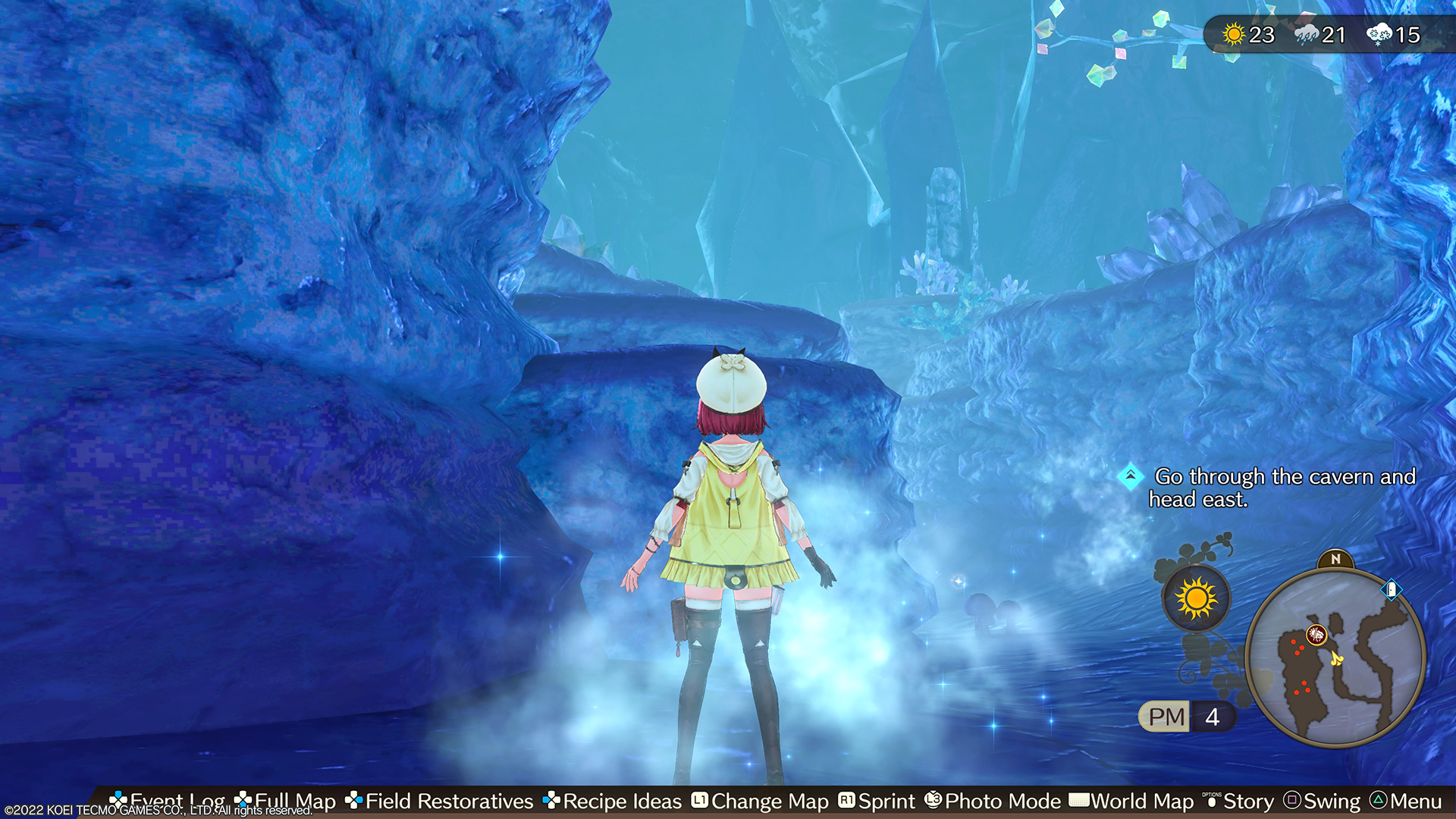
Dungeon maps are helpful in navigating such places but only to a point. For example, the Quartz Lapis map shows that there’s a path to explore a new area, but upon arrival, you can’t get to it. The platform to get across is on higher ground and you cannot jump high enough. This can put adventurers in a loop, thinking either it’s the only path to take or backtracking is needed. The map already provides a color difference to mark height levels, but it didn’t work in this specific area.
Many of these locations are large and laid out in a linear path. Players will journey through these puzzle-like layouts to not only watch the game’s events unfold but to collect ingredients for their alchemy. Each location feels different with its own unique layout and the scenery is beautiful, but at times, it feels like a chore to explore. Sometimes, you’ll find yourself circling around and end up back at the starting point if you aren’t paying attention. Other times, players can get stuck trying to figure out how to get across to a new path like the one described previously.
The game has a day/night cycle that works in conjunction with the in-game clock, minus some areas that are located in altered dimensions. The time of day doesn’t change how the game plays, but it does add details to the environment. For example, fireflies will fly around during the night, while butterflies will appear during the day. However, the weather changes that occur while exploring do make a difference on the gameplay.
Weather Girl
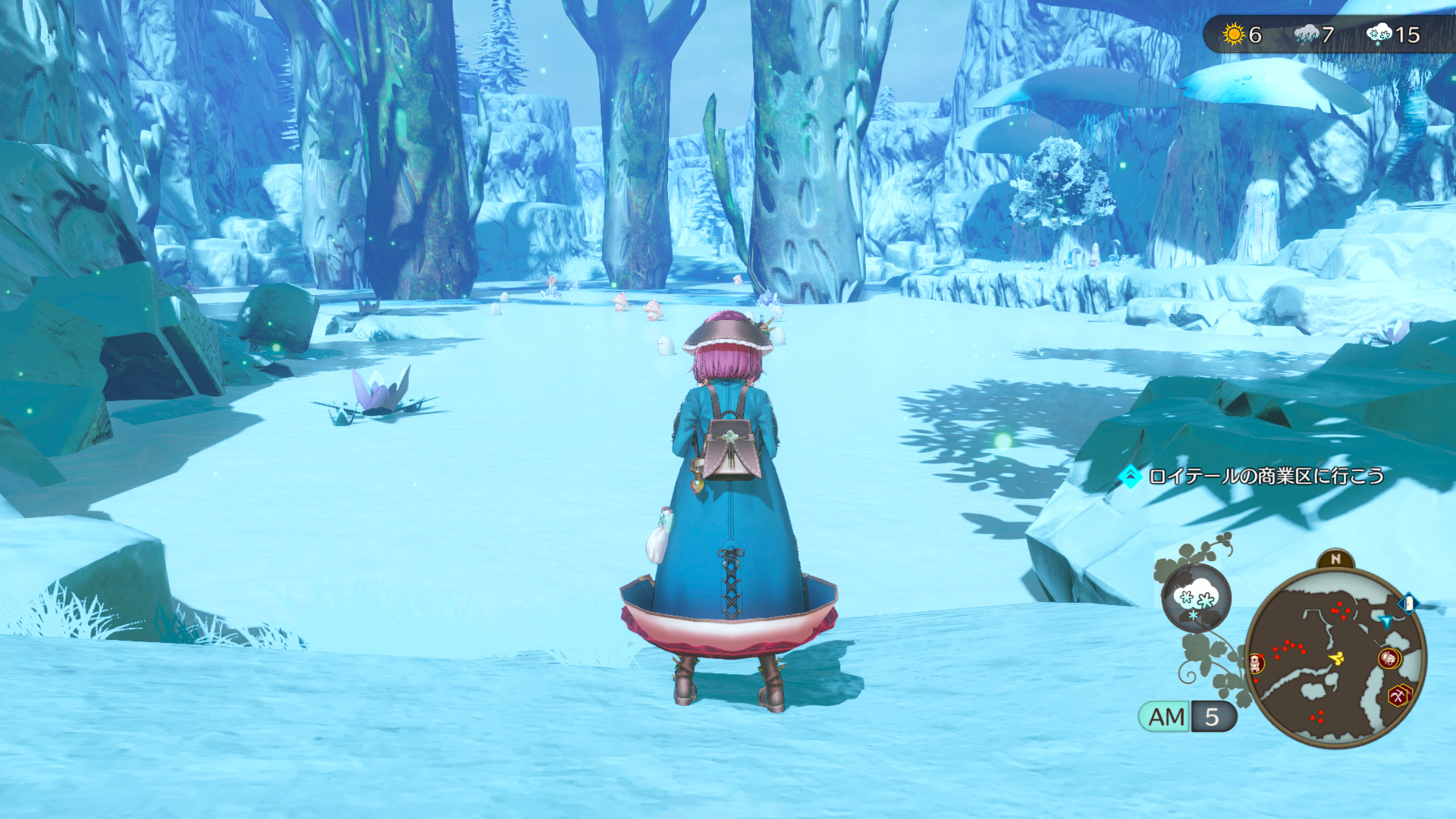
After visiting the first ruins in a new dimension, players will be able to change a level’s weather.
Podiums are placed across each exploration area. At these places, players can use a specific crystal energy to make a change to the forecast, such as rain or snow. Using the crystal will remove an energy point. Once it’s drained, you’ll need to add energy back into it by taking it back to your home and using alchemy. If players are stuck, the game gives stranded players easy access to go anywhere by pulling up the game’s map. Players can even restart the area without losing any items.
Making these weather changes alters the landscape and lets players explore other areas not in-reach before. Additionally, it swaps enemies and alchemy materials that are laying around. Each level already has its own twists and turns. Having the ability to change the weather adds even more puzzles for players to solve.
Trying to find alchemy materials laying in the snow could have been a pain. Thankfully, the developers made it easier for players to find them by adding a blue crystal that floats above them. That was a good design decision, devs!
Everyone Wins
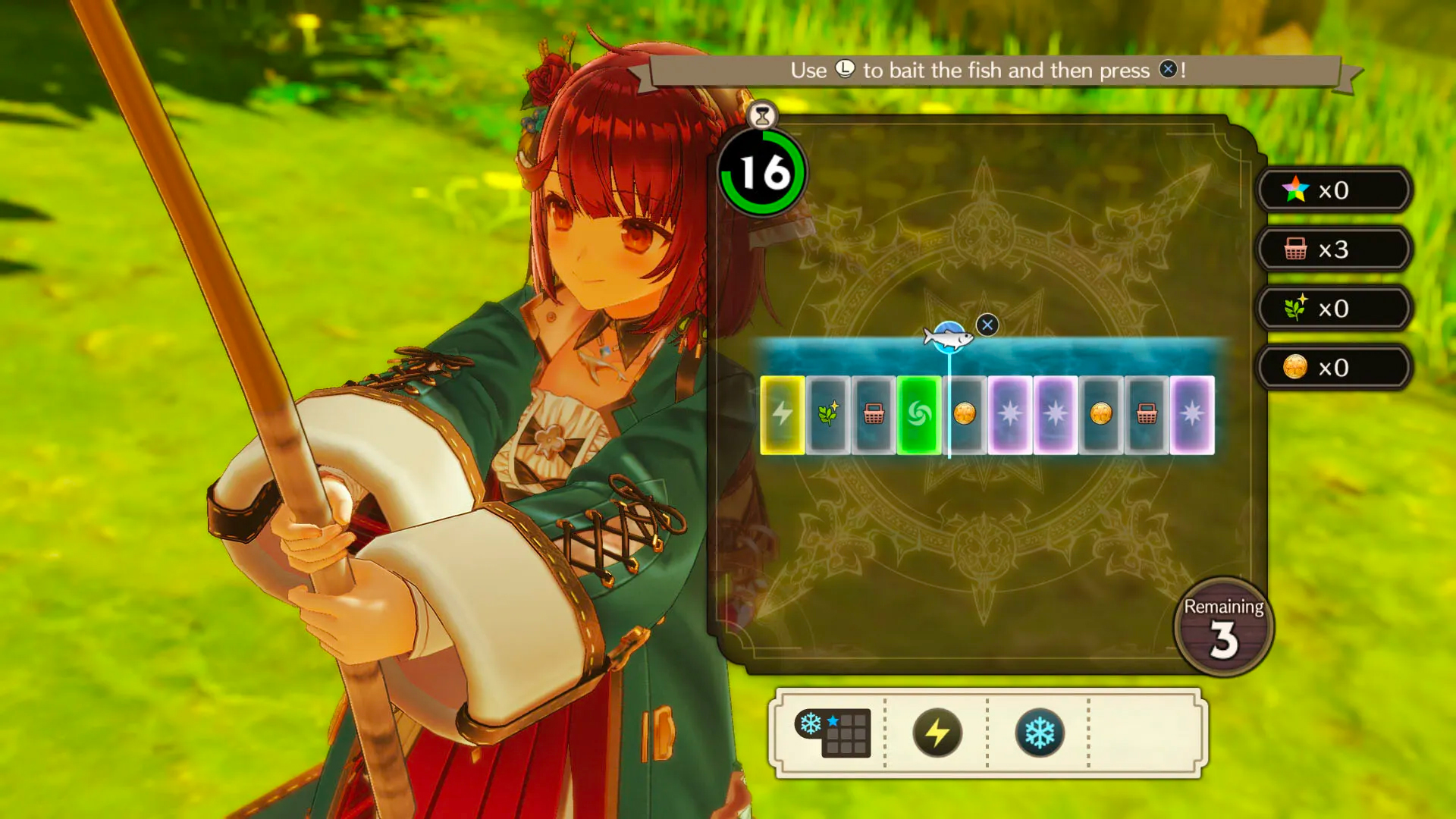
Sophie 2 looks to add more features when collecting ingredients. While exploring, players can be prompted with a minigame that can help enhance ingredient qualities. For instance, using the sickle, players can play a roulette-like table to pick up bonuses to your materials such as an increase of quantities. Each exploration tool offers a different minigame, but don’t expect to play every time you use it.
It’s certainly a different way to play, but some minigames like fishing can become too much of a hassle to try. Having to hold down the action button and release it in a timed gauge meter while waiting on a fish to swim to the nearest quality you want begins to wear down your patience. It’s a hit-and-miss style of gameplay that could use more adjustments.
Silver Crystal Pain

Alchemy crafting plays a significant role in driving the game’s story. Events won’t occur unless players synthesize specific items to continue. Even if you already have the item on-hand, creating the recipe requires players to obtain the item by finding or creating it when the game asks for it. The alchemy game gives all the necessary items relatively easily, with the help of the game’s encyclopedia.
However, there’s one specific item that’s difficult to obtain, the Silver Crystal. This crystal is needed to make the Glacial Larimar, a crystal that lets users summon snow during exploration. It must be found to continue the game’s storyline. Players can find this item in a specific spot in the Azura’s Pier vicinity of the Dusk Forest. Where exactly, the game does not tell you. Players will have to explore to find the specific spot. It’s difficult to find without researching online. The other option is to battle a strong enemy in the same area. However, the drop rate for this specific item is low, based on our playthrough. It can take at least a dozen battles to get one to drop. Additionally, these battles are not quick and take about 10 minutes to finish, depending on your character’s level. Of course, once you make the item and go to the next area, you can find them everywhere. Compared to the other story-driven items you need to create, Silver Crystals are a pain to find at first.
Tag Team Back Again

Enemies wander the map and battles take place only when you interact with them. There are no random battles. When engaged in battle, players can only have three members on the frontline to battle; the other three are backup. The only way to swap is either initiating a Twin Action attack or a Support Guard, or having a party member’s health points (HP) reach zero. It’s unfortunate that there’s no option in the battle menu to take a turn to swap spots with a backup member. If you’re going to have an option to flee battle, swapping should be there, too, if the character’s health is above zero.
Support Guard is a command to have a member from the backup team instantly swap places with a member on the frontline before an incoming attack. During battle, the option to swap and guard the attack will prompt, and players can choose which backup character should be swapped.
Twin Action is an interesting and fun attack option to use. Those who’ve used tag-team attacks in games like Chrono Trigger will enjoy how Sophie 2 handles team attacks. This style of attack is the way to go whenever available and can only be used if there are enough technical points (TPs) accumulated. To earn TPs, players have to perform basic attacks and block. Once enough are gained, the active character can pick another character from the back lineup to do a joint attack and swap places. Additionally, Twin Action reduces the cost of the chosen skill’s magic points (MP) by ten. For example, if one of Sophie’s skill attacks cost 10 MP, using Twin Action would bring it down to 0. Unfortunately, players cannot carry over TPs after the battle ends. Every battle resets the TP number to 0.
As you play, you’ll unlock a second style of tag-team attack called Dual Triggers. It offers one cinematic attack against enemies, dealing more damage than a Twin Attack. This stylish attack feels more like Chrono Trigger’s dual attack system. To initiate the Dual Trigger, players have to initiate a Twin Action or a Support Guard during battle. Once the gauge goes to 100%, the option becomes available. Once used, it resets to 0. However, unlike a Twin Action attack, the Dual Triggers gauge percentage can be carried over to a new battle.
These dual attack commands make the battlefield more interesting and entertaining. Hopefully, these combat mechanics will carry over to future Atelier games.
Simple, Clean Menus
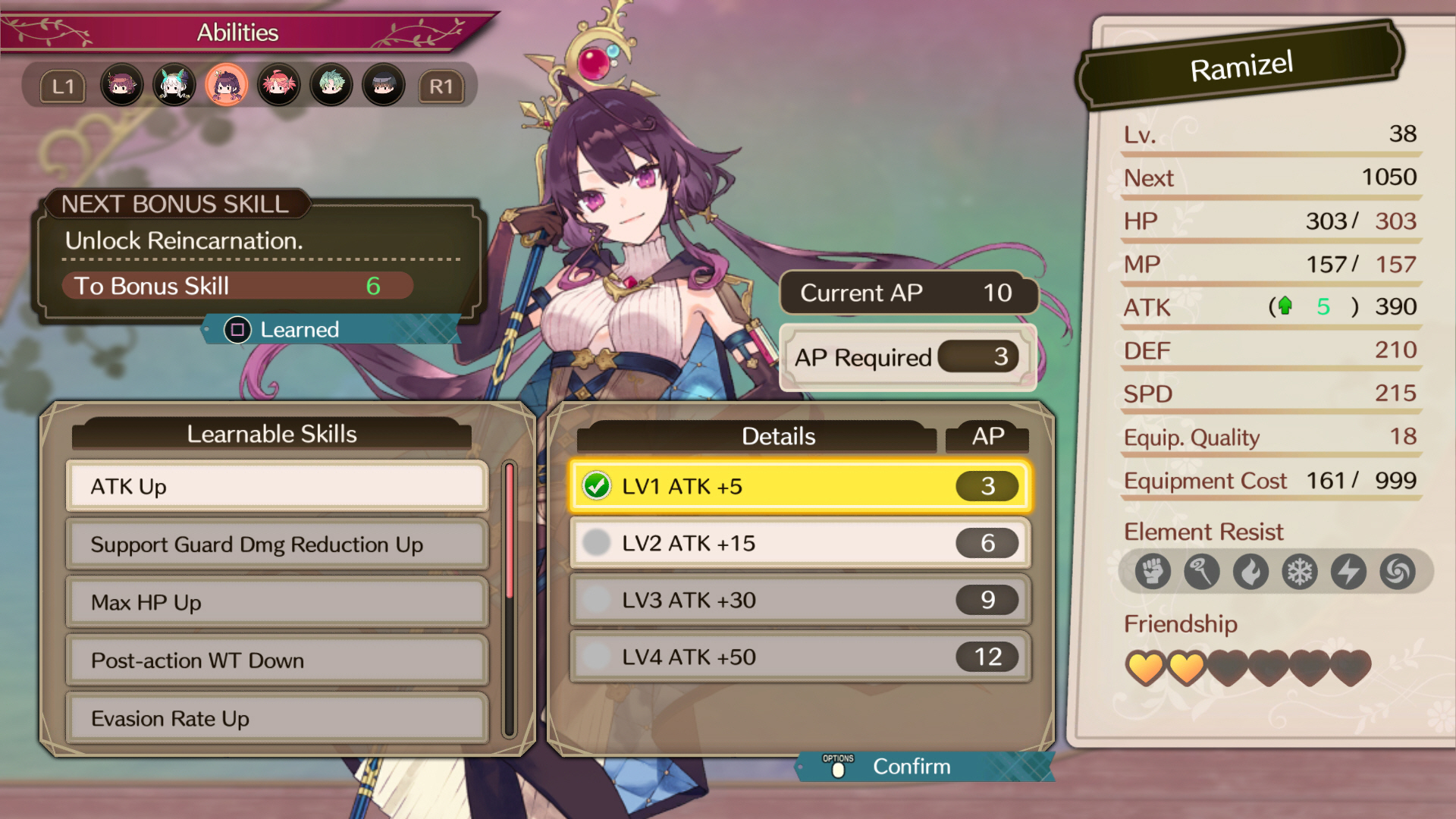
The battle mechanics weren’t the only things updated. The battle screen user interface (UI) also received a cleaner, simpler design. The Atelier games continue to modify and tweak the game’s UI, but with Sophie 2, it’s the simplest and cleanest thus far. Compared to the original Sophie game, the position of the party member status and the battle timeline turns are swapped, keeping the upper part of the screen open for those cinematic tag-team attacks. Menu screens are also cleaned up and organized in a way that’s easy on the eyes.
The game’s main menu when first opened is decorative and utilizes the entire screen’s space. It provides info about your party’s statuses, a run-down list of the game’s functionality, and an itemized report of your team’s alchemy levels, cash, etc. The run-down list is self explanatory. Players can check their basket of alchemy ingredients, change party equipment and the lineup, earn abilities for each party member, and read a guide filled with information such as enemy statuses and how to play the game. There’s always room for improvements such as adding mini animated clips in the game’s guide area to help show how certain functions work. Overall, it’s a solid setup.
Simple, Clean Alchemy
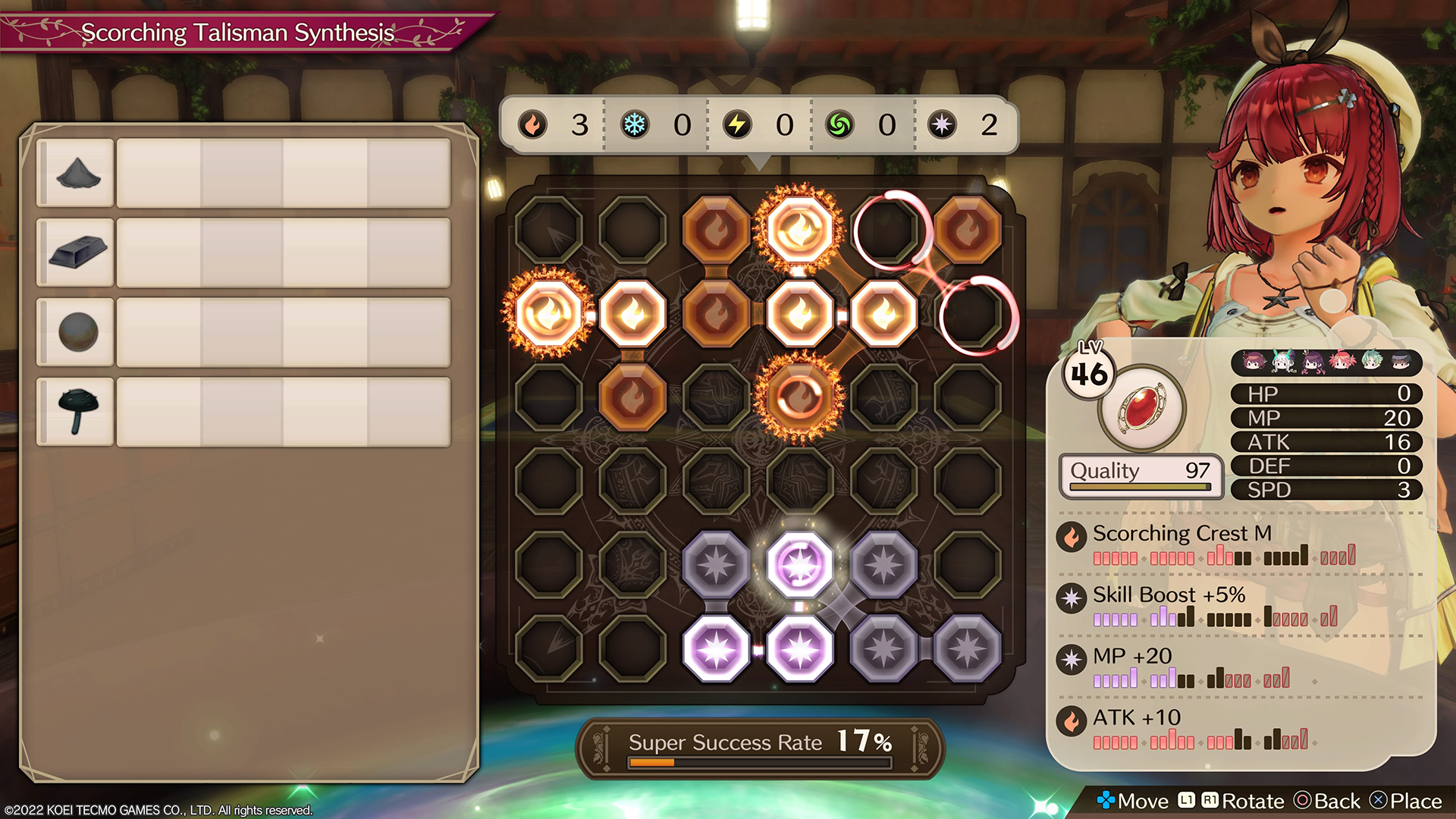
The Atelier series is known for its alchemy gameplay, and it’s the core of the game’s mechanics. Each entry to the series makes modifications to the UI while keeping the core mechanics intact. Combining items together can create an effect such as increased defense or cure poison. That trend continues in Atelier Sophie 2, enhancing the synthesizing of items. Compared to Atelier Ryza 2, one of the latest entries to the Atelier series, Sophie 2’s UI is simplified, clean, and easy to follow. Ryza 2’s was a lot to take in but looked graphically enhanced.
In Ryza 2, each alchemy was built in like a timeline. It’s much different in Sophie 2, where everything is built on a square grid and all activity stays on the board, just like its predecessor. Think of popular puzzle games like Bejeweled and Candy Crush. Players aren’t moving all over the screen; keeping things simple isn’t a bad thing. Compared to the original Sophie title, Sophie 2 is cleaned up and easier for players to use.
Before you can start throwing items into your cauldron, players will need a recipe to follow. Recipes are earned by either the game’s story events, by exploring, or by purchasing them at a local shop. Once you earn a “recipe idea,” you’re given a grocery list of what you’ll need. Most of the time, players will have to make another item with their alchemy, and find an item at an exploration area or purchase it at a shop. Some recipes are more specific about the type of material, while others are loose in the requirements. For example, to create cloth, you’ll need a couple silver webs, a plant, and an animal material.
Each ingredient contains a set of elements, such as fire, ice, and lightning. Some have one, but most have multiple elements per ingredient. These elements can help add effects to your final product, making your custom item a better quality than your average one at the local shop.
Once ingredients are picked, you’ll place your ingredients on the grid. Each ingredient is shaped like an orb and its color represents a specific element. For example, blue is for ice and orange is fire. Connecting the same elements next to each other can create a chain. The more chains there are, the higher the quality of the effects.
If you overlap a grid space, that initial element chain will disappear and you cannot bring it back unless you redo your grid setup. You can let the game automatically add the ingredients to the board, but it won’t be perfect and can potentially miss out on bonus enhancements. It’s recommended to use the auto mode for learning in the beginning and for quick alchemy tasks.
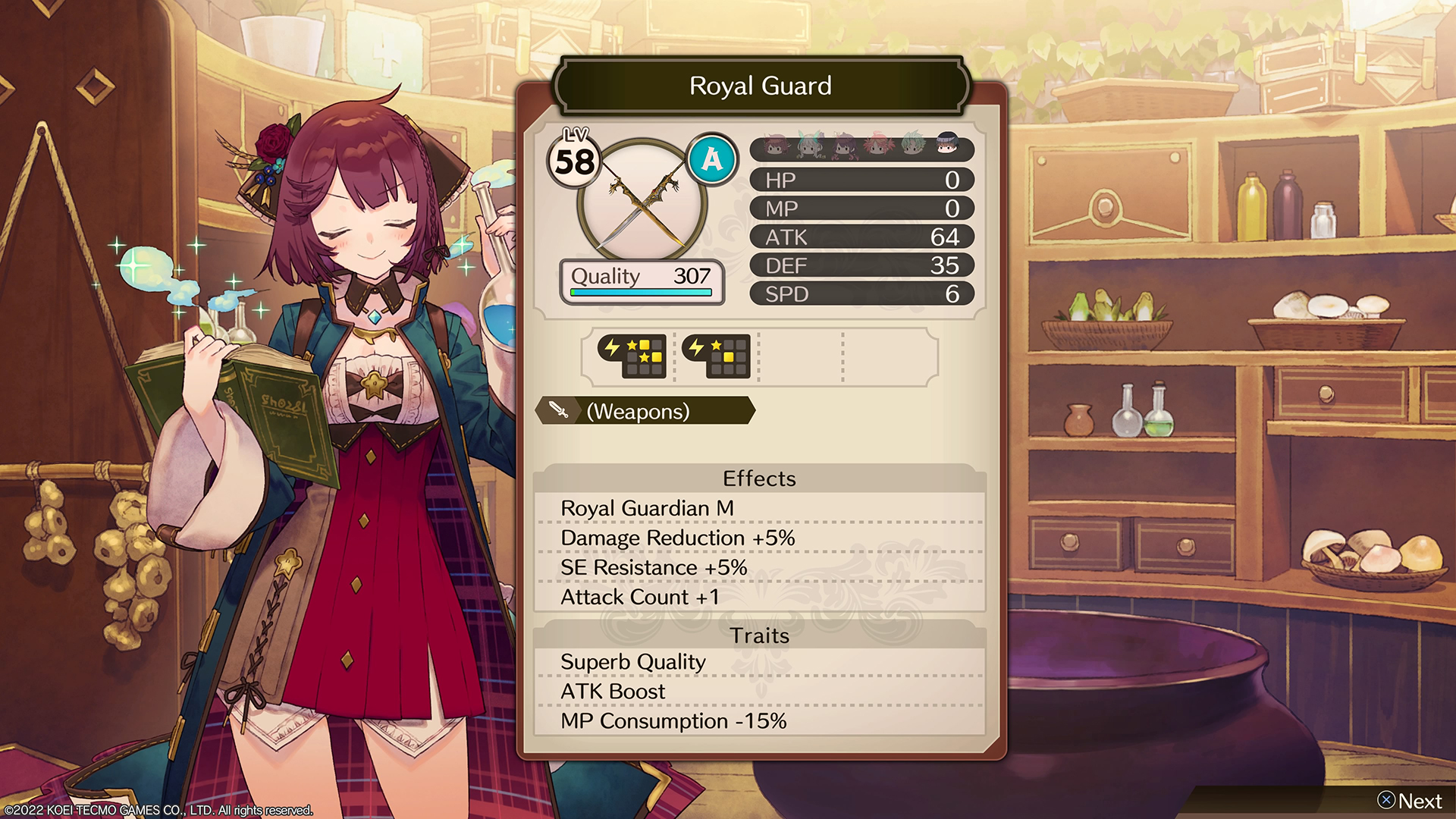
Additionally, materials can carry traits that can carry the item’s quality level, too, such as status enhancements. Traits are baked into the item. Effects are a bonus that are added into the item by alchemy.
The alchemy mechanics are a lot to take in when starting the game, and it can potentially take a couple hours to learn it. However, once you have the basics down, you can make some interesting quality items that can benefit your party’s equipment. And that’s not all; the game continues to throw in new mechanics, even halfway through the adventure. For instance, you eventually gain the ability to enhance your grid from 5×5 to a higher number. This helps you to create quality products good enough to be graded at an A or S rank.
While there’s a learning curve, the clean, simple UI significantly helps the player follow along and learn what’s happening. Alchemy feels more entertaining like a mini puzzle game, and that’s how it should be. Fun, simple, and addicting.
Service with a Smile
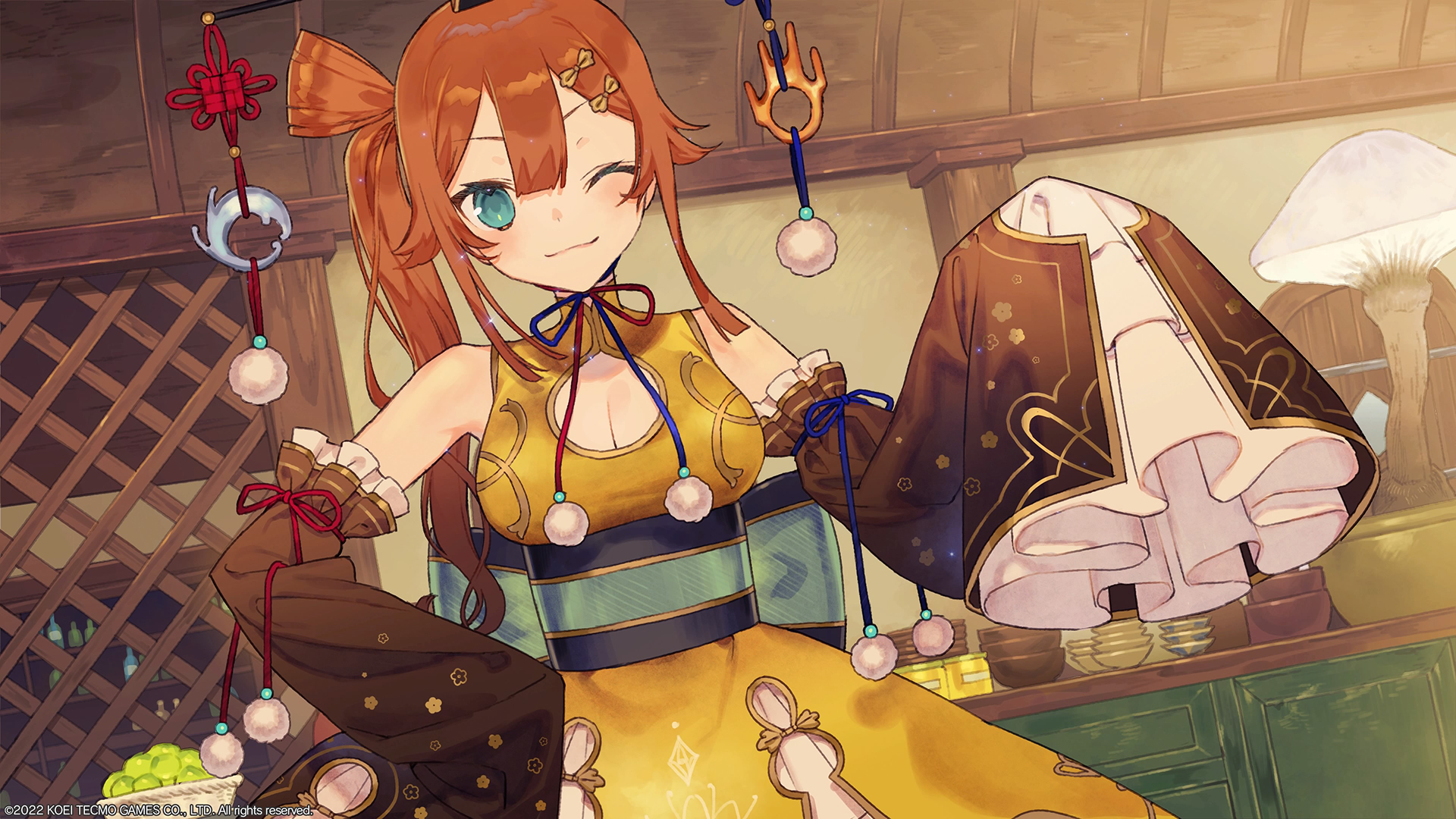
When players come up with a high quality product, it can be challenging to replicate it. In Sophie 2, a local shop in town can duplicate your item for a cost. It’s a great service in the alchemy game, since finding the same traits and quality is challenging on its own.
The other shops in town are located in the downtown area. Each one sells specific types of items. Even one of your party members runs one, and she sells a range of alchemy ingredients drawn from those you’ve come across during your recent expeditions. They’re all handy!
Still Vibrant, Still Gorgeous

Sophie 2 continues to carry the Atelier series’s vibrant color palette and anime-like illustrations. Like the other Atelier games, most of the female cast shows more details than the male characters. From their clothing to their personalities, you always feel more drawn to the girls.
The two male party characters feel the most lackluster. Olias’s and Diebold’s illustrations feel not up to par with the female cast. Their personalities don’t stand out as much either. For example, Diebold’s quiet personality makes it feel like he’s more of a secondary character. That said, not all female characters are top notch. The goddess in the dream world, Elvira, has a high-pitched voice that’ll make players cringe when she’s yelling. Even if Elvira is portrayed to have a child-like personality, the ears can only handle so much.
The game’s world, while colorful, also feels a bit dated. Tree branches and flowers look flat, and the leaves on the branches look like a simple paper craft. Flower beds also look off when animated in the wind, blowing the entire bush back and forth instead of some stems and a couple leaves. Clothing folds and textures appear flat, but the party’s design makes up for it, that is, unless the camera is too zoomed in to a character’s body. Sophie 2 isn’t going to win any awards for best graphics, but players should expect that before jumping into the game.
The game’s soundtrack is harmonic with a few chorus pieces that make it whimsical. While the long times spent exploring aren’t all fun, the score that plays is relaxing and helps make traveling easier. The game’s battle music isn’t groundbreaking when compared to games like Final Fantasy, but it has some upbeat to it. Also, boss battle scores don’t feel powerful when compared to the ordinary battle theme, which is odd.
The Final Recipe
Atelier Sophie 2 has a well-built alchemy setup and battle mechanics that make it enjoyable even if the overall game has an outdated look. Hopefully, these fun mechanics will reappear in an expanded form in future Atelier games. In the meantime, savor this good dream!
A PlayStation 4 code was provided for this review and gameplay footage. Atelier Sophie 2: The Alchemist of the Mysterious Dream available for the Nintendo Switch, PlayStation 4, and PC (Steam).


